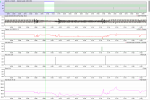05-09-2024, 04:58 PM
Therapy Thread and machine questions - unadvisedfun
Hi,
a little background: OSA diagnosis. based on at home sleep study, AHI around 30, RDI 40. Also suspected UARS. Started on APAP which didn't offer any relief of symptoms: hypertension, sleepiness, and cognition issues. Tried Bilevel and felt a little better but hypertension and cognition were not improving.
This winter I was able to get an in-lab sleep study. The results were that I had significant treatment emergent central apnea (TECSA) to the tune of about 80 AHI. This was also before obstructive apnea events were resolved at 11 EPAP /17 IPAP. The lab switched to ASV and I got the best half night of sleep I have had in a long time.
Doctor prescribed ASV PS min 3, PS max 15 EPAP min 5 backup rate 15 BPM and also recommended supplemental oxygen. I live at altitude as well. I have a resmed aircurve 10 ASV in ASVAuto mode but have also tried ASV mode.
I have gradually raised the minimum pressure support to 4 or 5 and I am feeling much better: lower blood pressure in the morning, better cognition during the day. I am finally starting to feel better.
Based on my data, it looks like when the pressure reaches about EPAP 5 IPAP 15 (pressure support 10) is where my breathing is just about perfect. Lankylefty27 also describes this in his UARS video how ASV get "stuck" at that higher pressure.
As soon as the ASV machine drops my IPAP below about 15, problems start. 100% flow limits, respiration rate doubles and the flow rate gets thrown into chaos. Some nights it rarely drops the pressure support, other nights it is constantly dropping the pressure support. In the attached example it was a good night where it stayed at pressure support 10 for most of the night.
As an experiment I dusted off my Vauto set to Vauto mode EPAP 5, IPAP 15, easy breathe enabled. I thought with the lower EPAP maybe the TECSA wouldn't be as "emergent". report showed an AHI of 30 centrals per hour (flow rate seemed to show many more that were unflagged). I am doubtful that the TECSA will self-resolve at this point.



a little background: OSA diagnosis. based on at home sleep study, AHI around 30, RDI 40. Also suspected UARS. Started on APAP which didn't offer any relief of symptoms: hypertension, sleepiness, and cognition issues. Tried Bilevel and felt a little better but hypertension and cognition were not improving.
This winter I was able to get an in-lab sleep study. The results were that I had significant treatment emergent central apnea (TECSA) to the tune of about 80 AHI. This was also before obstructive apnea events were resolved at 11 EPAP /17 IPAP. The lab switched to ASV and I got the best half night of sleep I have had in a long time.
Doctor prescribed ASV PS min 3, PS max 15 EPAP min 5 backup rate 15 BPM and also recommended supplemental oxygen. I live at altitude as well. I have a resmed aircurve 10 ASV in ASVAuto mode but have also tried ASV mode.
I have gradually raised the minimum pressure support to 4 or 5 and I am feeling much better: lower blood pressure in the morning, better cognition during the day. I am finally starting to feel better.
Based on my data, it looks like when the pressure reaches about EPAP 5 IPAP 15 (pressure support 10) is where my breathing is just about perfect. Lankylefty27 also describes this in his UARS video how ASV get "stuck" at that higher pressure.
As soon as the ASV machine drops my IPAP below about 15, problems start. 100% flow limits, respiration rate doubles and the flow rate gets thrown into chaos. Some nights it rarely drops the pressure support, other nights it is constantly dropping the pressure support. In the attached example it was a good night where it stayed at pressure support 10 for most of the night.
As an experiment I dusted off my Vauto set to Vauto mode EPAP 5, IPAP 15, easy breathe enabled. I thought with the lower EPAP maybe the TECSA wouldn't be as "emergent". report showed an AHI of 30 centrals per hour (flow rate seemed to show many more that were unflagged). I am doubtful that the TECSA will self-resolve at this point.
- on my resmed aircurve 10 ASV I can't raise the pressure support minimum above 6. are there any other non-philips ASV machines that can do this? can the aircurve 11 ASV support a higher minimum pressure support?
- Because of the TECSA should I try bilevel ST (spontaneous timed) with a small backup rate or am I better off sticking with ASV? or something else?







